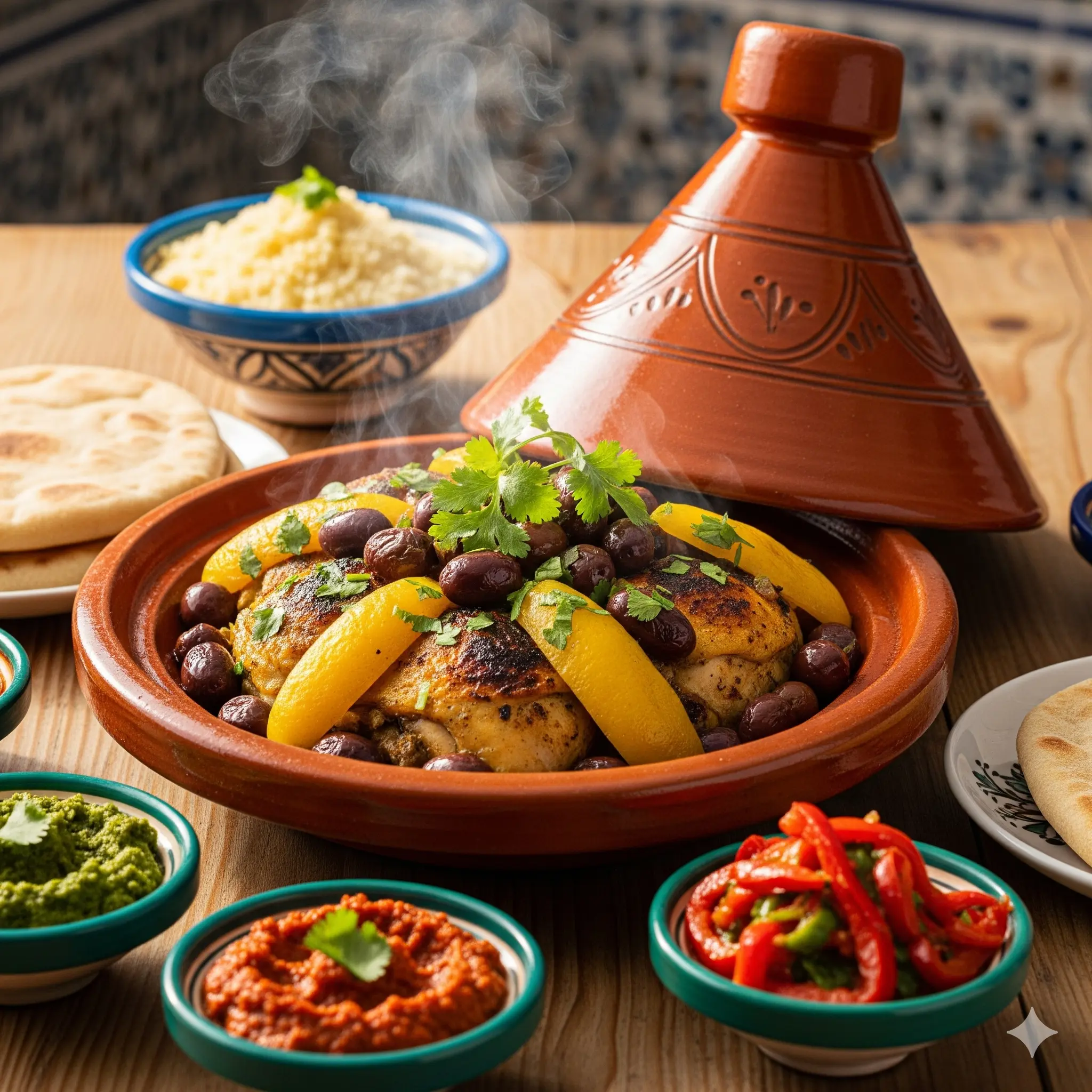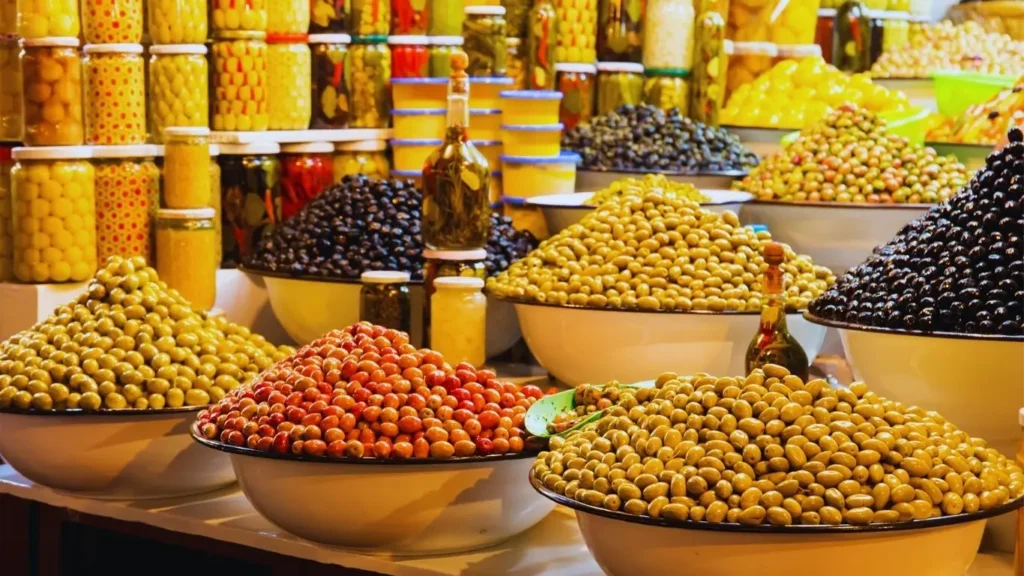Easy Recipe for Moroccan Tagine with Meslalla Olives

Moroccan tagine stands among the world’s most celebrated dishes in Arab and Mediterranean cuisine, masterfully blending historical essence with authentic Moroccan flavors. When it comes to Meslalla tagine with olives, we’re discussing a true culinary masterpiece that carries centuries of expertise and cooking traditions within its aromatic depths.
Moroccan cuisine, long considered one of the world’s most diverse culinary traditions due to Morocco’s historical interactions with the outside world over centuries, presents in tagine the quintessence of this remarkable cultural and culinary diversity.
History and Origins of Moroccan Tagine
The Historical Genesis of Tagine
The tagine, as pronounced in Morocco, simultaneously refers to both a clay cooking vessel and the North African Moroccan dish prepared within it, standing as one of Morocco’s most famous traditional dishes. This ancient dish transcends mere sustenance—it represents a cultural symbol narrating the story of an illustrious civilization.
Traditional Tagine Design
The traditional tagine vessel consists entirely of heavy clay that may be decorated or glazed. It comprises two parts: the base, which is a flat depression with a slightly raised circular edge, and the lid, a cone-shaped dome placed over the base during cooking.
This unique design serves more than aesthetic purposes—it fulfills crucial practical functions. The conical lid helps recondense steam and return it to the food, preserving moisture and natural flavors throughout the cooking process.
Meslalla Olives: Morocco’s Authentic Treasure
Understanding Meslalla Olives
Meslalla olives represent a special variety of Moroccan olives distinguished by their unique flavor and crispy texture. The preparation method for “Meslalla” olives involves subjecting green harvested olives to initial selection to sort the largest, blemish-free, and deformation-free specimens, followed by washing the selected quantity.
The Importance of Olives in Moroccan Cuisine
Morocco, which ranked first in the Arab world and sixth globally in olive production in 2016 with approximately 1,416,000 tons of olives, stands among the world’s most important producers of this precious crop. This abundant production explains the central role of olives in traditional Moroccan cooking.
Popular Types of Moroccan Tagine
Chicken Tagine with Onions (Tagine Djej Besla)
This type of chicken tagine with onions ranks among favorite dishes in Moroccan households. It features tender chicken combined with caramelized onions and aromatic spices. One of the most famous Moroccan chicken tagine recipes includes preparation with onions and potatoes.
Goat Meat Tagine (Tagine Lma3zi)
Goat meat tagine represents a traditional dish prepared for special occasions. This dish requires cooking expertise and extended cooking time to achieve tender meat and rich flavor.
Pea and Bean Tagine (Tagine Jelbana o L9o9)
Pea and bean tagine combines peas and beans in a delicious and nutritious vegetarian mixture. This dish provides an excellent option for vegetarians, containing high-quality plant proteins.
Purple Olive Tagine (Tagine Zitoune Violet)
Purple olive tagine utilizes a special variety of purple olives that impart distinctive color and unique flavor to the dish. This tagine type typically includes seasonal vegetables.
Potato and Olive Tagine (Tagine Pommes de Terre Olives)
Potato and olive tagine offers an economical yet delicious dish combining potatoes and olives in a wonderful mixture. This dish proves ideal for large families and can be prepared with ease.
Nutritional Benefits of Moroccan Tagine
Comprehensive Nutritional Value
Moroccan tagine provides rich, diverse nutritional elements, including varieties containing meat and others featuring various vegetables such as potatoes, carrots, tomatoes, and peppers, along with natural spices like saffron, cumin, and olives, making it a nutritionally complete meal.
Health Benefits of Meslalla Olives
Meslalla olives are rich in monounsaturated fatty acids, antioxidants, and vitamin E. These components contribute to:
- Improving heart and cardiovascular health
- Fighting natural inflammation in the body
- Enhancing absorption of fat-soluble vitamins
- Supporting skin and hair health
Traditional and Modern Tagine Preparation Methods
The Traditional Method
The traditional approach requires using authentic clay vessels and cooking over gentle heat for extended hours. Slow cooking represents the secret: cooking over low heat for extended periods ensures optimal meat tenderness and rich flavor absorption.
Modern Alternatives
Using Electric Ovens
Place ingredients in a tagine, add potatoes, olives, and chicken broth. Put the tagine in the oven and leave until fully cooked.
Pressure Cooker Method
Modern pressure cookers offer the possibility of preparing tagine in less time while maintaining authentic flavor.
Using Slow Cookers
This method proves ideal for those wanting to prepare tagine mlaj or any other type without constant monitoring.
Authentic Meslalla Olive Tagine Recipe
Essential Ingredients
For Meat or Chicken:
- 1 kg meat or chicken, cut into medium pieces
- 2 onions, sliced
- 3 tablespoons olive oil
- 1 teaspoon ground ginger
- 1 teaspoon turmeric
- 1/2 teaspoon cinnamon
- Pinch of black pepper
For Olives and Vegetables:

- 2 cups pitted Meslalla olives
- 3 tomatoes, diced
- 2 carrots, sliced into rounds
- 1 cup chicken or meat broth
- Salt to taste
- Fresh cilantro leaves for garnish
Detailed Preparation Method
Phase One: Preparing the Meat
- Marinating the Meat: Mix meat pieces with ginger, turmeric, cinnamon, salt, and black pepper. Allow marinade absorption for at least 30 minutes.
- Browning the Meat: In a tagine pot or deep skillet, heat olive oil over medium heat. Add marinated meat pieces and brown on all sides until golden.
- Adding Onions: Add onion slices and cook until wilted and light golden.
Phase Two: Building the Tagine
- Adding Tomatoes: Add diced tomatoes and cook until dissolved, forming a natural sauce.
- Adding Broth: Pour chicken or meat broth until ingredients are covered. Bring to a boil, then reduce heat.
- Slow Cooking: Cover the pot and simmer over low heat for 1.5 hours for chicken or 2 hours for meat.
Phase Three: Final Touches
- Adding Olives: In the last 30 minutes of cooking, add Meslalla olives and sliced carrots.
- Serving: After ensuring meat tenderness and flavor integration, garnish with fresh cilantro leaves.
Professional Cooking Tips
Ingredient Selection
Meat Quality
Choose meat cuts containing minimal fat and bones, such as shoulder or thigh, as they provide richer flavor during slow cooking.
Olive Quality
Use fresh spices: For optimal flavor, use authentic Meslalla olives and avoid poor-quality canned varieties.
Advanced Cooking Techniques
Temperature Control
Maintaining steady, gentle heat represents the secret to tagine success. Optimal temperature ranges between 160-180°C in the oven.
Ingredient Timing
- Meats: Initially for golden browning
- Hard vegetables (carrots, potatoes): Mid-cooking
- Soft vegetables (tomatoes, olives): Final third
- Fresh herbs: End for garnish
Traditional Serving and Accompaniments
Authentic Serving Methods
Tagine is traditionally served in the same vessel in which it was cooked, maintaining temperature and flavor. The pot is placed in the table’s center for family sharing.
Perfect Accompaniments
Moroccan Bread
Traditional Moroccan bread (urban bread) serves as tagine’s primary accompaniment, used for absorbing delicious broth and eating meat and vegetable pieces.
Moroccan Tea
A glass of Moroccan mint tea provides the perfect conclusion to a tagine meal, aiding digestion and completing the authentic taste experience.
Storing and Preserving Tagine
Refrigeration
Tagine can be refrigerated for 3-4 days in tightly sealed containers. In fact, flavor improves on the second day!
Freezing
For freezing, separate broth from solid pieces and store in separate containers. Frozen tagine can be kept for up to 3 months.
Reheating
When reheating, add a little water or broth to restore original consistency, heating over low heat until reaching desired temperature.
Tagine in Modern Kitchens
Modern Cooking Tools
Electric Pressure Cookers
Reduce cooking time by half while maintaining authentic flavor.
Modern Ovens
Ovens with even heat distribution provide excellent tagine results.
Slow Cookers
Perfect for preparing tagine mlaj or any other type with minimal effort.
Modern Kitchen Tips
- Use Cooking Timers: To ensure proper cooking without overdoing
- Monitor Internal Temperature: To verify perfect meat doneness
- Use High-Quality Tools: For optimal results
The Cultural Significance of Tagine
Symbol of Moroccan Identity
Tagine transcends culinary boundaries to become a symbol of Moroccan cultural identity. Its preparation represents a social ritual bringing families together around shared meals, strengthening bonds through communal dining experiences.
Hospitality Traditions
In Moroccan culture, offering tagine to guests represents the highest form of hospitality. The slow preparation process demonstrates care and respect for visitors, while the communal serving style reflects traditional values of sharing and togetherness.
Regional Variations Across Morocco
Coastal Variations
Coastal regions of Morocco often incorporate seafood into their tagine preparations, creating unique combinations of fish, olives, and preserved lemons that reflect maritime influences.
Mountain Traditions
Mountain regions favor heartier versions with lamb or goat meat, incorporating wild herbs and mountain vegetables that grow in higher altitudes.
Desert Influences
Southern regions near the Sahara often include dates and nuts in their tagine preparations, creating sweet and savory combinations that reflect desert trade route influences.
Modern Adaptations and Health Considerations
Dietary Modifications
Contemporary cooks have adapted traditional tagine recipes to accommodate various dietary needs:
- Vegetarian Versions: Using legumes and seasonal vegetables
- Low-Sodium Options: Reducing salt content while maintaining flavor through spices
- Gluten-Free Preparations: Naturally gluten-free when served without bread
Nutritional Optimization
Modern nutritional understanding has highlighted tagine’s health benefits:
- High antioxidant content from spices and vegetables
- Healthy fats from olive oil and olives
- Complete protein sources from meat or legume combinations
- Rich mineral content from diverse ingredients
Conclusion: Tagine as Morocco’s Culinary Ambassador
Moroccan tagine with Meslalla olives transcends being merely a dish—it represents a complete cultural and sensory experience combining flavor, tradition, and hospitality. Whether choosing the traditional method with authentic clay vessels or practical modern alternatives, the true secret lies in selecting high-quality ingredients, patience in the cooking process, and above all, the love and passion invested in preparing this exceptional dish.
From chicken tagine with onions to goat meat tagine, and from pea and bean tagine to purple olive tagine, each variety carries its own unique story and tradition. Moroccan cuisine, which occupies a prestigious place globally, presents in tagine the essence of centuries of culinary expertise and creativity.
Moroccan tagine remains a symbol of warm hospitality and ancient traditions, serving as a bridge connecting the illustrious past with the evolving present, and extending an open invitation to explore the enchanting world of Moroccan flavors.
The art of tagine preparation continues to evolve while maintaining its fundamental character, proving that true culinary traditions adapt without losing their essence. As global interest in authentic, slow-cooked meals increases, Moroccan tagine with Meslalla olives stands ready to captivate new generations of food enthusiasts worldwide, carrying forward Morocco’s rich culinary heritage into the future.

1 thought on “Easy Recipe for Moroccan Tagine with Meslalla Olives”